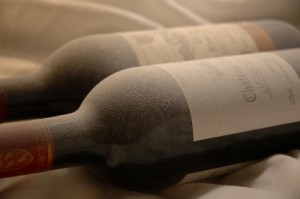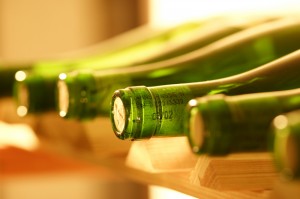by Lorri | Jan 4, 2012 | UnCorked
 A few weeks ago, my husband and I nervously pulled the cork of a bottle we had tended for almost 15 years. Many occasions came and went with the discussion of whether it was too early, late or the perfect time.
A few weeks ago, my husband and I nervously pulled the cork of a bottle we had tended for almost 15 years. Many occasions came and went with the discussion of whether it was too early, late or the perfect time.
Only a small percentage of the world’s wines improve with age so it’s a wonderful moment when pure patience wins over anticipation in the battle of cellaring a bottle.
Wine does not have to be expensive to show the benefits of aging. Some Napa Valley Cabernets can gain spectacular benefits in 10 years while some Bordeaux transform after a hundred. Consider these tips on aging wines.
SPARKLING
Champagne, second to Bordeaux, may have the most distorted view of being age worthy. Aged Champagne can be described as an acquired taste. It loses its zip and bubble, making it much like a yeasty still wine. Avid collectors savor the taste but if you were given a bottle as a wedding gift 20 years ago, most likely it will not be what you are expecting. Most sparkling wines and nonvintage Champagne are best when opened within two years of bottling.
FORTIFIED
Fortified wines like Port and Madeira are best bets for long-term cellaring. It’s the combination of high alcohol and sugar slowing down the natural deterioration over time.
REDS
Long-term cellaring of Burgundy is a lot like playing the stock market; unless you know the producer, it’s a gamble. The same can be said of California pinot noir.
When the age-worthy pinot noir offers its combination of acidity, tannin and concentration, it is a masterpiece. But unless the growing conditions and the winemaker’s technique were perfect, most pinot noir is best consumed within two to four years.
CLIMATE CONTROL
Wine storage is generally the most important factor in successful aging. The lower the temperature, the slower the maturation. In general the more slowly a wine intended for aging matures, the greater complexity of the flavors. Also, in general the smaller the bottle size the faster its contents mature.
TO AGE OR NOT TO AGE (AND FOR HOW LONG)
A wine’s potential for aging depends on many factors including vintage, producer and storage conditions. The following is a general guideline for wines intended for cellaring: Cabernet sauvignon: four to 20 years Merlot: two to 12 years Nebbiolo: four to 20 years Pinot noir: two to eight years Sangiovese: two to eight years Tempranillo: two to 10 years Chardonnay: one to six years Riesling: two to 30 years Semillon (dry): two to seven years Semillon (botrytised): five to 25 years
by Lorri | Jan 6, 2010 | UnCorked
 The new year is a prime time for wine collectors to organize, plan, purge and simply freshen up the wine cellar. It is also the ideal time for taking stock of your collection. Here are a few cellar housekeeping tips.
The new year is a prime time for wine collectors to organize, plan, purge and simply freshen up the wine cellar. It is also the ideal time for taking stock of your collection. Here are a few cellar housekeeping tips.
Most wines should be consumed within one to two years. If you receive a bottle of wine as a gift, unless you know or were told it would age, open and enjoy it in the next six months. Don’t let a wine deteriorate in your collection because you assumed a fancy label or unfamiliar brand implied cellar storage.
Wine tags (paper labels that look similar to “do not disturb” hotel room door tags that slip over the neck of the bottle) are a convenient tool for organizing your cellar. For avid collectors these tags can be used to identify vintages and rare single bottles without movement in your cellar and for everyday cellar management the tags can be used as reminders of when to open, or even note if the bottle was a gift or purchased for a specific occasion.
Wine tags are also a great way to leave instructions for others who may be choosing wine from your collection with notes such as “Everyday Wine for Dinner,” “Ask Me First,” “Don’t Touch” or “Sacred.”
Whether you are a beginning collector or one who proudly boasts a cellar filled with treasures it is a good idea to keep an organized inventory. Remember, simplicity is key. A computer program is a good way to keep track of wines in your cellar, but you can do the same job with handwritten bottle tags or even the uncomplicated pad and pencil.
Cellaring is not only for long-term aging; consider adding everyday wines in your cellar space to retain their quality.
THE VALUES
- 2006 Stephen Vincent Crimson Red, California (about $16, retail)
- 2007 Hogue Cabernet Sauvignon, Washington (about $15 retail)
- 2008 Montinore Estate Pinot Gris, Oregon (about $17 retail)
- 2006 Murphy-Goode Liar’s Dice Zinfandel, California (about $17 retail)
- 2007 Cellar No. 8 Merlot, California (about $10 retail)
- 2007 Arido Malbec, Argentina (about $10 retail)
- 2007 Santi Pinot Grigio, Italy (about $16 retail)
Wines intended to age will change over time; some will mellow and others will evolve into perfection. The following are possible additions to your cellar created for aging.
THE SPLURGES
- 2006 Don Melchor Cabernet Sauvignon, Chile (about $110 retail)
- 2007 Honig Cabernet Sauvignon, California (about $54 retail)
- 2006 Kistler Vineyards Hyde Vineyard Chardonnay, California (about $99 retail)
- 2006 E. Guigal Chateauneuf du Pape, France (about $82 retail)
by Lorri | May 6, 2009 | UnCorked
How to properly store wine is a frequent query from Uncorked readers.
Start with the storage conditions.
The optimum temperature is 52 degrees but anywhere from 40 to 65 degrees is safe. However, fluctuation causes inconsistent aging as wines mature faster at higher temperatures and slower at lower, so try to keep the temperature as constant as possible.
Second, keeping wines away from vibration, direct sunlight and excessive dampness is important for a slow, secure cellar slumber.
And finally, placing the bottles on their sides ensures the corks stay in contact with the wine — upright storage can cause the cork to dry out, exposing the wine to air and resulting in oxidation.
But even with these seemingly strict guidelines, there is no need to call in a cellar designer or rush out to buy a state-of-the-art cellaring cooler. Depending on the size and value of your collection, there are many options to fit almost any budget.
THE VALUES
- The bottom of a dark closet, bottles on their sides on the floor (free)
- A small six- to 12- bottle decorative wine rack available at department and specialty stores ($24-$80)
- Magic Chef 8 Bottle Wine Cooler (Model MCWC8DSCT) available at Home Depot (about $99)
THE SPLURGES
- Renting Professional Cellar Space such as Tuscany Wine Vaults at U-Storit in Little Rock. (501) 666-5700 ($20-$200, monthly)
- Grand Cru 800 Wine Cellar Cooling Unit available at WineEnthusiast.com. (about $399)
- Eurocave Performance 283 Service Package Wine Cellar with three temperatures available at WineEnthusiast.com. ($2,500-$4,000 retail)
- Custom built, contact your local builder ($500-$10,000)
by Lorri | Jan 7, 2009 | UnCorked
The new year always comes with the inspiration to organize and plan my wine cellar — what I want to drink, what I want to buy and what I want to give away.
When considering what wines to drink right away, it’s important to remember that not all wines are meant to age. Most are meant to be consumed within one to two years after bottling. For these youngsters, time is the enemy.
Keeping track of what you have is also important. Nothing is more distressing than having a wine go bad because it was saved for a special occasion that never came. Some occasions are worthy of a special wine, but a good bottle of wine is perfect any day of the year.
Staying organized is the best way to get the most out of your wine collection. A computer program is a good way to keep track of wines in your cellar, but you can do the same job with a pad and pencil.
THE VALUES
Many think cellaring is only for wines that will receive long term aging, but even everyday drinking wines need proper storage conditions to retain their quality. For wines to purchase, I recommend retail store specials, promotional wines and any exceptional value to add to your cellar collection. Keep in mind, however, that the following should be consumed within months rather than years.
- 2006 Mark West Pinot Noir, California (about $12, retail)
- 2007 Bogle Vineyards Chardonnay, California (about $10, retail)
- 2006Concha y Toro Casillero Del Diablo Carmenere, Chile (about $10, retail)
- 2006 Honig Sauvignon Blanc, Napa Valley, California (about $16, retail)
- 2007 Brancott Vineyards Sauvignon Blanc, New Zealand (about $15, retail)
THE SPLURGES
Wines intended to age will change over time; some will mellow and others will evolve into perfection. The following are possible additions to your cellar created for aging.
- 2003 Quintessa Cabernet Sauvignon, California (about $140, retail)
- 2004 Twomey Cellars Merlot, California (about $84, retail)
- 1997 Taylor Fladgate Vintage Port, Portugal (about $98, retail)
- 2006 Inniskillin Ice Wine, Canada (about $59 for a 375 ml, retail)
- NV Jackson-Triggs Vidal Icewine, Canada (about $24 for a 187 ml, retail)
- Fonseca Aged Tawny Port (20 Year), Portugal (about $62, retail)
 A few weeks ago, my husband and I nervously pulled the cork of a bottle we had tended for almost 15 years. Many occasions came and went with the discussion of whether it was too early, late or the perfect time.
A few weeks ago, my husband and I nervously pulled the cork of a bottle we had tended for almost 15 years. Many occasions came and went with the discussion of whether it was too early, late or the perfect time.